6. Emergency Assistance The Hormone Adrenaline
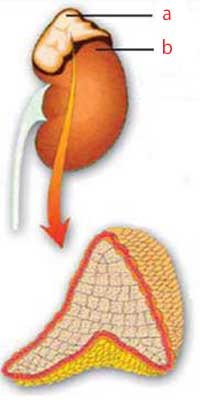 |
| a. Adrenal gland |
In times of fear or danger, there is a molecule that helps every human being: adrenaline. For example, this hormone puts the brain of a pilot whose plane has engine trouble into a state of alarm. It sends more blood and sugar to his brain cells, enabling the pilot to exercise greater care and attention. At the same time, it raises his pulse and blood pressure, enabling him to be more alert and react more quickly. It gives the muscles extra strength, raises the level of sugar in the bloodstream and thus enables the pilot to generate the extra energy he needs.
This miraculous hormone produced—and stored—by the adrenal glands possesses many properties and is a proof of God's sublime knowledge and immaculate creation.
How does adrenaline give rise to these effects? When danger arises, the equivalent of an alarm button is pressed in the body. The brain issues a lightning-fast command to the adrenal glands. Cells inside the gland enter a state of activation and secrete adrenaline molecules. Entering the bloodstream, these molecules are distributed to various regions of the body. (Figures 29 through 32).
The adrenaline molecules thus released broaden the blood vessels, leading to such vital organs as the brain, heart and muscles. In this way, these organs thus obtain the extra oxygen and nutrients they require to cope with an emergency.5(Figure 32)
As the adjustments performed by the adrenaline widen blood vessels leading to the heart, brain and muscles, they also narrow those going to the liver and skin (Figure 33).
Adrenaline has a different significance for every organ it encounters. When going to the blood vessels, it expands them, and when it goes to the heart, it accelerates the contraction of the muscle cells there. In this way, the heart beats faster, and the muscles obtain the extra circulation they need to produce extra strength (Figure 34).
The body is thus given the support it needs in the best possible manner.
There is another reason for the skin to receive less blood: This way, any risk of blood loss in the event of injury is reduced to a minimum. The pallor appearance of someone who is terrified or extremely excited arises from less blood being pumped to the skin at that moment.6
The vessels leading to the heart or brain are never narrowed by mistake, and those leading to the liver or skin are never expanded. The adrenaline molecule does its job very well. The diameters of the hundreds of blood vessels in the body and the amount of blood transmitted by these, and to where, are all regulated by a hormone, in quantities too small to be detected with ordinary senses.
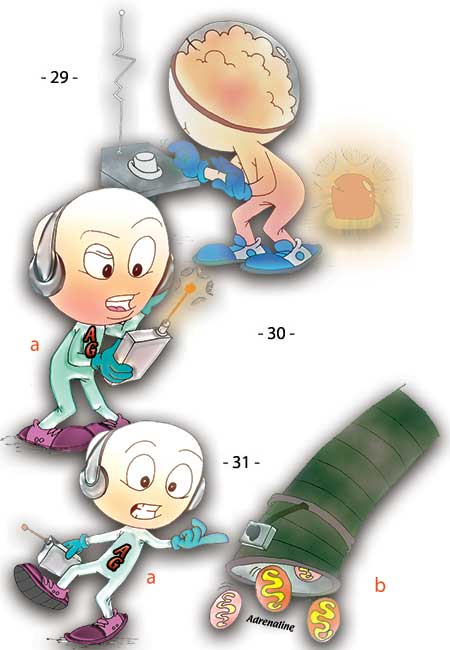 |
| a. AG = Adrenal Gland |
| Figure 29: At times of fear or excitement, the brain quickly sends a signal to the adrenal glands. Figure 30: Cells in the internal part of the adrenal gland immediately go to action status. Figure 31: And the hormone adrenaline is secreted in quantity. |
When the adrenaline molecule reaches muscle cells, it enables them to contract more powerfully (Figure 35). Adrenaline molecules arriving at the liver, command cells there to release more sugar into the blood. The level of sugar in the bloodstream thus rises, and the muscles obtain the extra fuel they require (Figure 36).
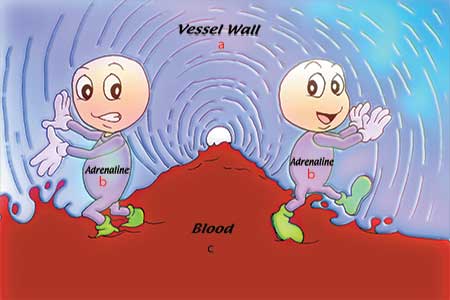 |
| a. Vessel Wall |
| Figure 32: The hormone adrenaline widens the arteries leading to such vital organs as the brain, heart and muscles, and thus increases the flow of blood to these organs. |
This very small adrenaline molecule knows very well what it has to do, and when, and never places the human body into a state of alarm so long as it perceives no need. In addition, it never forgets what kind of command it must issue to the different cells it encounters. Moreover, this all goes to show that this hormone is very well acquainted with the cells and organs and their functions. Nor does it ever make a mistake over when the state of alarm needs to come to an end, or the body might suffer irreparable damage due to overstimulation.
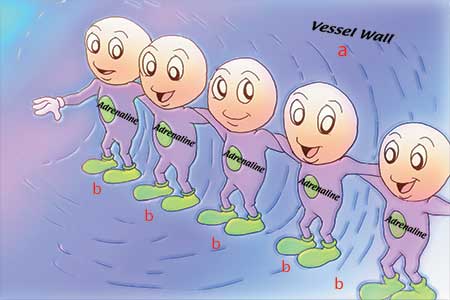 |
| a. Vessel Wall |
| Figure 33: By narrowing the blood vessels leading to the liver and skin, adrenaline prevents blood from flowing to organs where it will not be needed, for the time being. |
However, this tiny molecule functions in apparent knowledge of this responsibility. How can a molecule consisting of a few atoms combined in a specific sequence—which is inanimate, unconscious and possesses no brain or eyes—exhibit such intelligent, organized and rapid behavior? Is it possible for all these actions to take place through the intelligence and will of a quantity of fluid too small to be seen with the naked eye? Of course not!
 |
| Figure 34 and 35: Thanks to adrenaline, the human body gains extra strength and resistance at times of stress. |
Everything we have described here is simply evidence that proves that God has created every molecule in our bodies, which molecules act according to the power, will, control and command of Almighty God at every moment, throughout the course of our lives. Almighty God manifests His might, power, and the sublime knowledge and intelligence in His creation at all times and in all places.
As God reveals in the Qur'an:
What is in the heavens and in the earth belongs to God. God encompasses all things. (Surat an-Nisa', 126)
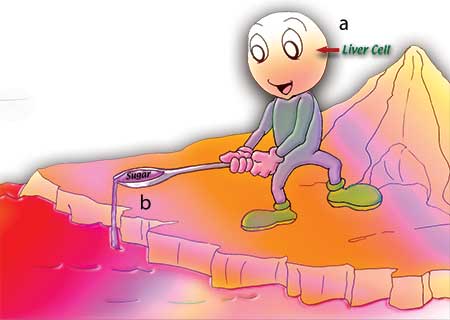 |
| a. Liver cell |
| Figure 36: Adrenaline molecules reaching the liver command the cells there to release more sugar into the bloodstream. The level of sugar in the bloodstream rises as a result. |
Footnotes
5- Eldra Pearl Solomon, Insan Anatomisine ve Fizyolojisine Giris (“Introduction to Human Anatomy and Physiology”), translated by Dr. L. Bilkem Suzen, Istanbul, Birol Basin Yayin Dagitim, Aug 1997, p. 140
6- Musa Ozet, Osman Arpaci, Biyoloji 2 (“Biology 2”), p. 133.
- Introduction
- 1. Monitors That Control the Level of Fluids in the Blood
- 2. The Body's Impeccable Security System
- 3. Mother's Milk and the Hormone Oxytosin
- 4. Calcium Measurers
- 5. The Sugar Factory
- 6. Emergency Assistance The Hormone Adrenaline
- 7. The Lysosomal Enzymes That Purify the Body
- 8. The Flowless System That Regulates Blood Pressure
- 9. Growth Hormone
- 10. The Clock in Our Bodies That Never Goes Wrong
- 11. The Miraculous Molecule That Regulates Body Temperature
- 12. An Extraordinarily Delicate Balance
- 13. Hormones That Prepare the Way For the Baby -1
- 14. Hormones That Prepare the Way For the Baby -2
- 15. The Hormones in the Male Reproductive System
- 16. Other Properties of the Hormone Testosterone
- 17. Hemoglobin: The Miraculous Oxygen – Bearing Molecule
- 18. The Communications System in the Cell
- 19. The Messenger Hormone's Journey within the Cell
- 20. Communication Control in the Cell
- 21. Protein Traffic within the Cell
- 22. Chemical Communication in the Nerve Cell
- 23. Nitric Oxide: A Skilled Messenger
- 24. The Endothelial Cell: A Nitric Oxide Production Center
- 25. The Power Station in the Human Body
- 26. The
- 27. DNA Replication
- 28. Repair Enzymes
- 29. Protein Production
- 30. The Final Stage of Protein Production
- 31. The Cell Membrane and 100 Trillion Organized Workers
- 32. What Happens at the Moment of Hearing?
- 33. Blood Clotting
- 34. The Immune System
- 35. The Journey of Vitamin B12
- 36. The Pancreas: The Human Body's Chemist
- 37. Transporter Molecules in the Cell Membrane
- 37. Complement Proteins Responsible for Protecting the Body
- 39. Anti – Acid Formulas Producing Molecules
- 40. The Consciousness Displayed by Egg Cells
- Conclusion
